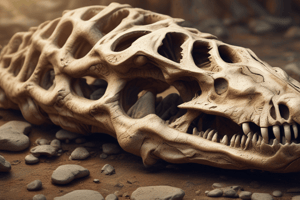Podcast
Questions and Answers
Fossils are exclusively the preserved remains of animals, not plants.
Fossils are exclusively the preserved remains of animals, not plants.
False (B)
Body fossils provide insight into the behavioral patterns of ancient organisms.
Body fossils provide insight into the behavioral patterns of ancient organisms.
False (B)
Sedimentary rock layers form relatively quickly, allowing for rapid fossilization.
Sedimentary rock layers form relatively quickly, allowing for rapid fossilization.
False (B)
The youngest layer of sedimentary rock is typically found at the bottom.
The youngest layer of sedimentary rock is typically found at the bottom.
Scientists can determine how animals adapted to environmental changes by studying fossils.
Scientists can determine how animals adapted to environmental changes by studying fossils.
Trace fossils are formed when a skeleton or shell hardens and is preserved in stone.
Trace fossils are formed when a skeleton or shell hardens and is preserved in stone.
Fossils provide limited information about the diets of ancient creatures.
Fossils provide limited information about the diets of ancient creatures.
Fossilized plant remains can help reveal what types of plants thrived in ancient landscapes.
Fossilized plant remains can help reveal what types of plants thrived in ancient landscapes.
Fossils only provide information related to the physical appearance of extinct organisms.
Fossils only provide information related to the physical appearance of extinct organisms.
Fossilization occurs more readily if the remains of a plant or animal are buried within layers of sediment.
Fossilization occurs more readily if the remains of a plant or animal are buried within layers of sediment.
Flashcards
What is a fossil?
What is a fossil?
Preserved remains or imprints of ancient plants and animals that provide clues about Earth's history.
What are body fossils?
What are body fossils?
Fossils formed when a skeleton or shell hardens and is preserved in stone.
What are trace fossils?
What are trace fossils?
Fossils that are tracks, trails, and burrows that help scientists determine how organisms moved and lived.
Where are fossils found?
Where are fossils found?
Signup and view all the flashcards
What do scientists learn from fossils?
What do scientists learn from fossils?
Signup and view all the flashcards
Study Notes
- Fossils are the preserved remains or imprints of ancient plants and animals.
- Fossils provide important clues about Earth's history.
- Fossils can help people learn about the appearance, diet, and habits of creatures that lived long ago.
- Fossilized plants also reveal the types of plants that thrived in ancient landscapes.
Types of Fossils
- There are two main types of fossils: body and trace.
- Body fossils form when a skeleton or shell hardens and is preserved in stone.
- Body fossils help scientists understand physical characteristics of an organism.
- Trace fossils include tracks, trails, and burrows.
- Trace fossils can help scientists understand how organisms moved and lived.
Finding Fossils
- Sedimentary rock forms when layers of sediment settle in an area over long periods.
- The oldest layer is found at the bottom, and the youngest layer is at the top.
- Fossilization is more likely to occur if the remains of a plant or animal are buried within these layers.
- When scientists discover fossils in different rock layers, the characteristics of the fossil are studied for clues.
- These pieces of evidence help people understand the organisms that once existed and how the Earth has changed.
- Fossils can help people figure out how animals adapted to changing environments, how climates shifted, and even why some animals disappeared.
Studying That Suits You
Use AI to generate personalized quizzes and flashcards to suit your learning preferences.




